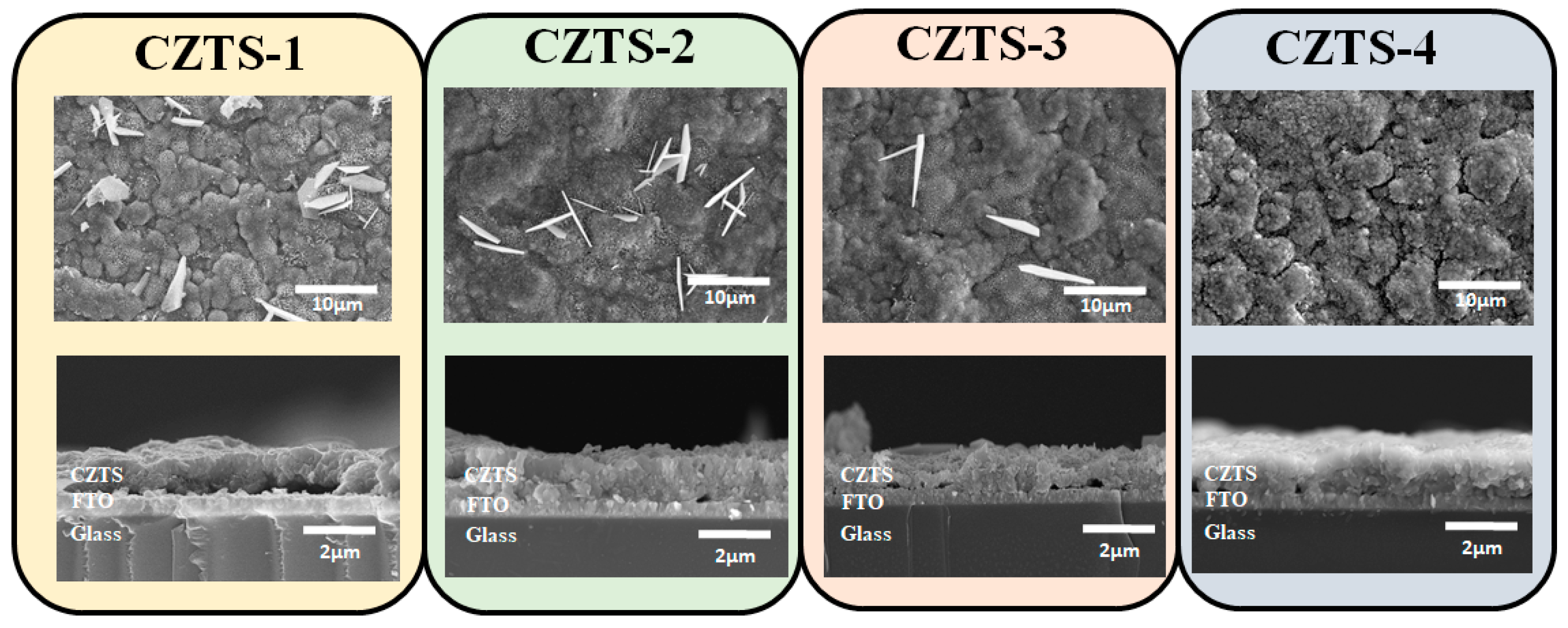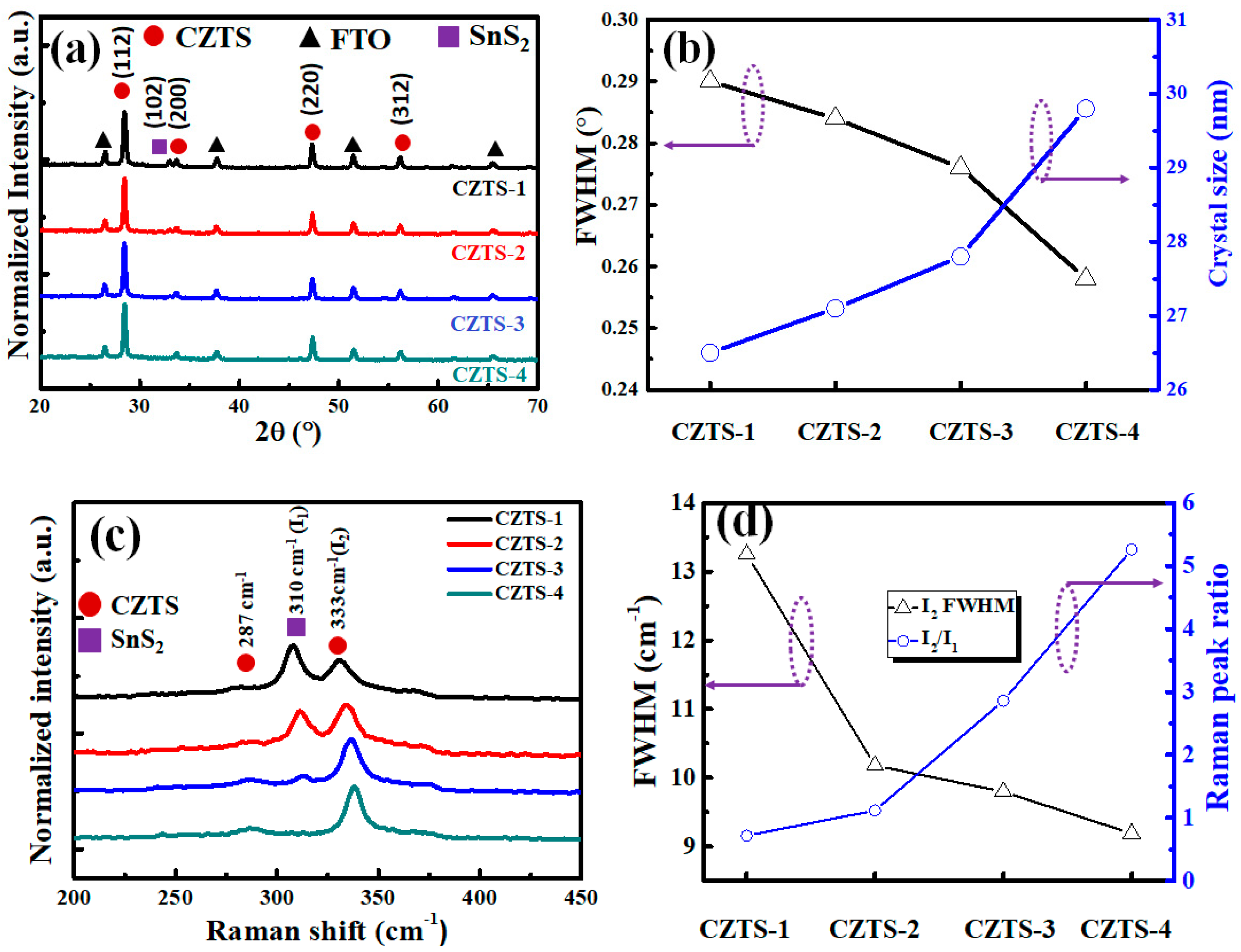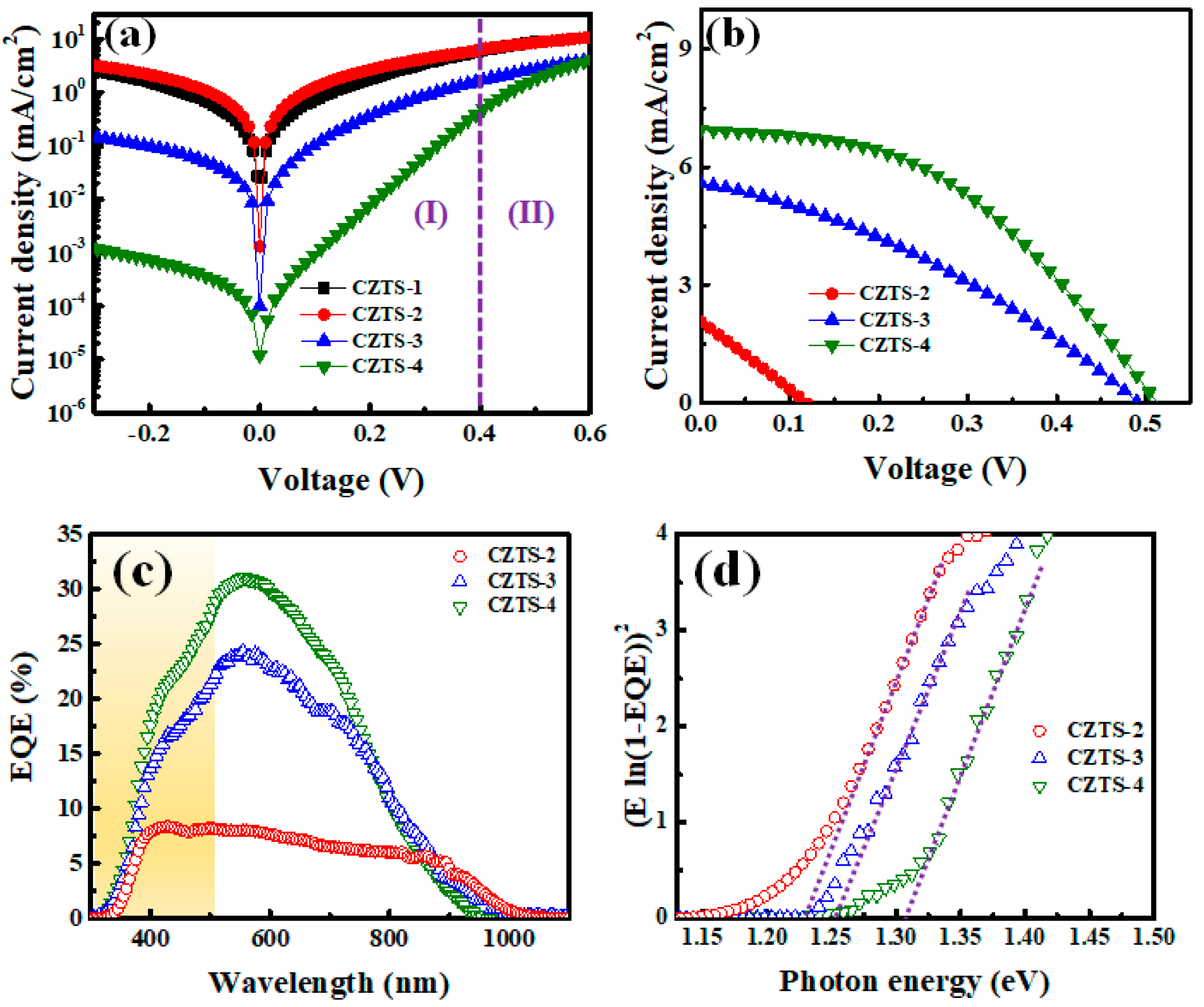Suppression of SnS2 Secondary Phase on Cu2ZnSnS4 Solar Cells Using Multi-Metallic Stacked Nanolayers
Abstract
:1. Introduction
2. Materials and Methods
3. Results and Discussion
4. Conclusions
Author Contributions
Funding
Institutional Review Board Statement
Informed Consent Statement
Data Availability Statement
Acknowledgments
Conflicts of Interest
References
- Yoshikawa, K.; Kawasaki, H.; Yoshida, W.; Irie, T.; Konishi, K.; Nakano, K.; Uto, T.; Adachi, D.; Kanematsu, M.; Uzu, H.; et al. Silicon heterojunction solar cell with interdigitated back contacts for a photoconversion efficiency over 26%. Nat. Energy 2017, 2, 17032. [Google Scholar] [CrossRef]
- Jackson, P.; Wuerz, R.; Hariskos, D.; Lotter, E.; Witte, W.; Powalla, M. Effects of heavy alkali elements in Cu(In,Ga)Se2 solar cells with efficiencies up to 22.6%. Phys. Status Solidi-R 2016, 10, 583–586. [Google Scholar] [CrossRef] [Green Version]
- Metzger, W.K.; Grover, S.; Lu, D.; Colegrove, E.; Moseley, J.; Perkins, C.L.; Li, X.; Mallick, R.; Zhang, W.; Malik, R.; et al. Exceeding 20% efficiency with in situ group V doping in polycrystalline CdTe solar cells. Nat. Energy 2019, 4, 837–845. [Google Scholar] [CrossRef]
- Rajeshmon, V.G.; Sudha Kartha, C.; Vijayakumar, K.P.; Sanjeeviraja, C.; Abe, T.; Kashiwaba, Y. Role of precursor solution in controlling the opto-electronic properties of spray pyrolysed Cu2ZnSnS4 thin films. Sol. Energy 2011, 85, 249–255. [Google Scholar] [CrossRef]
- Sharmin, A.; Bashar, M.S.; Sultana, M.; Mostafa Al Mamun, S.M. Sputtered single-phase kesterite Cu2ZnSnS4 (CZTS) thin film for photovoltaic applications: Post annealing parameter optimization and property analysis. AIP Adv. 2020, 10, 015230. [Google Scholar] [CrossRef] [Green Version]
- Khemiri, N.; Chamekh, S.; Kanzari, M. Properties of thermally evaporated CZTS thin films and numerical simulation of earth abundant and non toxic CZTS/Zn(S,O) based solar cells. Sol. Energy 2020, 207, 496–502. [Google Scholar] [CrossRef]
- Tsai, H.W.; Chen, C.W.; Thomas, S.R.; Hsu, C.H.; Tsai, W.C.; Chen, Y.Z.; Wang, Y.C.; Wang, Z.M.; Hong, H.F.; Chueh, Y.L. Facile Growth of Cu2ZnSnS4 Thin-Film by One-Step Pulsed Hybrid Electrophoretic and Electroplating Deposition. Sci. Rep. 2016, 6, 19102. [Google Scholar] [CrossRef] [Green Version]
- Diwate, K.; Mohite, K.; Shinde, M.; Rondiya, S.; Pawbake, A.; Date, A.; Pathan, H.; Jadkar, S. Synthesis and Characterization of Chemical Spray Pyrolysed CZTS Thin Films for Solar Cell Applications. Energy Procedia 2017, 110, 180–187. [Google Scholar] [CrossRef]
- Su, Z.; Sun, K.; Han, Z.; Cui, H.; Liu, F.; Lai, Y.; Li, J.; Hao, X.; Liu, Y.; Green, A.M. Fabrication of Cu2ZnSnS4 solar cells with 5.1% efficiency via thermal decomposition and reaction using a non-toxic sol–gel route. J. Mater. Chem. A 2014, 2, 500–509. [Google Scholar] [CrossRef]
- Ghosh, S.; Yasmin, S.; Ferdous, J.; Saha, B.B. Numerical Analysis of a CZTS Solar Cell with MoS2 as a Buffer Layer and Graphene as a Transparent Conducting Oxide Layer for Enhanced Cell Performance. Micromachines 2022, 13, 1249. [Google Scholar] [CrossRef]
- Zhou, J.; Xu, X.; Duan, B.; Wu, H.; Shi, J.; Luo, Y.; Li, D.; Meng, Q. Regulating crystal growth via organic lithium salt additive for efficient Kesterite solar cells. Nano Energy 2021, 89, 106405. [Google Scholar] [CrossRef]
- Wang, W.; Winkler, M.T.; Gunawan, O.; Gokmen, T.; Todorov, T.K.; Zhu, Y.; Mitz, D.B. Device characteristics of CZTSSe thin-film solar cells with 12.6% efficiency. Adv. Energy Mater. 2014, 4, 1–5. [Google Scholar] [CrossRef]
- Son, D.H.; Kim, S.H.; Kim, S.Y.; Kim, Y.I.; Sim, J.H.; Park, S.N.; Jeon, D.H.; Hwang, D.K.; Sung, S.J.; Kang, J.K.; et al. Effect of solid-H2S gas reactions on CZTSSe thin film growth and photovoltaic properties of a 12.62% efficiency device. J. Mater. Chem. A 2019, 7, 25279–25289. [Google Scholar] [CrossRef] [Green Version]
- Mali, S.S.; Patil, B.M.; Betty, C.A.; Bhosale, P.N.; Oh, Y.W.; Jadkar, S.R.; Devan, R.S.; Ma, Y.R.; Patil, P.S. Novel synthesis of kesterite Cu2ZnSnS4 nanoflakes by successive ionic layer adsorption and reaction technique: Characterization and application. Electrochim. Acta 2012, 66, 216–221. [Google Scholar] [CrossRef]
- Mahajan, S.; Stathatos, E.; Huse, N.; Birajdar, R.; Kalarakis, A.; Sharma, R. Low cost nanostructure kesterite CZTS thin films for solar cells application. Mater. Lett. 2018, 210, 92–96. [Google Scholar] [CrossRef]
- Ge, J.; Chu, J.; Jiang, J.; Yan, Y.; Yang, P. Characteristics of In-Substituted CZTS Thin Film and Bifacial Solar Cell. ACS Appl. Mater. Interfaces 2014, 6, 21118–21130. [Google Scholar] [CrossRef]
- Wang, Z.; Tao, J.; Xiao, W.; Xu, T.; Zhang, X.; Hu, D.; Ma, Z. Influence of deposition potential on Cu2ZnSnS4 thin–film solar cells co–electrodeposited on fluorine–doped tin oxide substrates. J. Alloys Compd. 2017, 701, 465–473. [Google Scholar] [CrossRef]
- Ge, J.; Yu, Y.; Ke, W.; Li, J.; Tan, X.; Wang, Z.; Chu, J.; Yan, Y. Improved Performance of Electroplated CZTS Thin-Film Solar Cells with Bifacial Configuration. ChemSusChem 2016, 9, 2149–2158. [Google Scholar] [CrossRef]
- Kim, H.T.; Kim, D.; Park, C. Temperature Effects on Cu2ZnSnS4(CZTS) Films De-posited by Spraying Method, Molecular Crystals and Liquid. Crystals 2012, 564, 155–161. [Google Scholar] [CrossRef]
- Olgar, M.A. Optimization of sulfurization time and temperature for fabrication of Cu2ZnSnS4 (CZTS) thin films. Superlattice Microst 2019, 126, 32–41. [Google Scholar] [CrossRef]
- Olgar, M.A.; Klaer, J.; Mainz, R.; Levcenco, S.; Just, J.; Bacaksiz, E.; Unold, T. Effect of precursor stacking order and sulfurization temperature on compositional homogeneity of CZTS thin films. Thin Solid Film. 2016, 615, 402–408. [Google Scholar] [CrossRef]
- Yoo, H.; Kim, J. Growth of Cu2ZnSnS4 thin films using sulfurization of stacked metallic films. Thin Solid Film. 2010, 518, 6567–6572. [Google Scholar] [CrossRef]
- Babichuk, I.S.; Semenenko, M.O.; Golovynskyi, S.; Caballero, R.; Datsenko, O.I.; Babichuk, I.V.; Li, J.; Xu, G.; Qiu, R.; Huang, C.; et al. Control of secondary phases and disorder degree in Cu2ZnSnS4 films by sulfurization at varied subatmospheric pressures. Sol. Energy Mater. Sol. Cells 2019, 200, 109915. [Google Scholar] [CrossRef]
- Mendis, B.G.; Goodman, M.C.J.; Major, J.D.; Taylor, A.A.; Durose, K.; Halliday, D.P. The role of secondary phase precipitation on grain boundary electrical activity in Cu2ZnSnS4 (CZTS) photovoltaic absorber layer material. J. Appl. Phys. 2012, 112, 124508. [Google Scholar] [CrossRef]
- Xie, H.; Sánchez, Y.; López-Marino, S.; Espíndola-Rodríguez, M.; Neuschitzer, M.; Sylla, D.; Fairbrother, A.; Izquierdo-Roca, V.; Pérez-Rodríguez, A.; Saucedo, E. Impact of Sn(S,Se) Secondary Phases in Cu2ZnSn(S,Se)4 Solar Cells: A Chemical Route for Their Selective Removal and Absorber Surface Passivation. ACS Appl. Mater. Interfaces 2014, 6, 12744–12751. [Google Scholar] [CrossRef]
- Wang, W.; Chen, G.; Cai, H.; Chen, B.; Yao, L.; Yang, M.; Chen, S.; Huang, Z. The effects of SnS2 secondary phases on Cu2ZnSnS4 solar cells: A promising mechanical exfoliation method for its removal. J. Mater. Chem. A 2018, 6, 2995–3004. [Google Scholar] [CrossRef]
- Chen, W.C.; Chen, C.Y.; Tunuguntlaa, V. Enhanced solar cell performance of Cu2ZnSn(S,Se)4 thin films through structural control by using multi-metallic stacked nanolayers and fast ramping process for sulfo-selenization. Nano Energy 2016, 30, 762–770. [Google Scholar] [CrossRef]
- Shi, S.; He, G.; Zhang, M.; Song, X.; Li, J.; Wang, X.; Cui, J.; Chen, X.; Sun, Z. Microstructural, optical and electrical properties of molybdenum doped ZnO films deposited by magnetron sputtering. Sci. Adv. Mater. 2012, 4, 193–198. [Google Scholar] [CrossRef]
- González-Castillo, J.R.; Vigil-Galán, O.; Rodríguez, E.; Jiménez-Olarte, D.; Leal, J.J. Cu6Sn5 binary phase as a precursor material of the CZTSe compound: Optimization of the synthesis process, physical properties and its performance as an absorbing material in a solar cell. Mater. Sci. Semicond. Process. 2021, 134, 106016. [Google Scholar] [CrossRef]
- Pandey, K.; Mohanty, B.C. Influencing mechanism of post-sulfurization with sulfur flakes on phase evolution and Schottky diode characteristic of Cu2ZnSnS4 thin films sputter deposited from a single target. Sol. Energy 2021, 228, 333–338. [Google Scholar] [CrossRef]
- Nagaoka, A.; Yoshino, K.; Taniguchi, H.; Taniyama, T.; Miyake, H. Preparation of Cu2ZnSnS4 single crystals from Sn solutions. J. Cryst. Growth 2012, 341, 38–41. [Google Scholar] [CrossRef]
- Ma, D.; Zhou, H.; Zhang, J.; Qian, Y. Controlled synthesis and possible formation mechanism of leaf-shaped SnS2 Nanocrystals. Mater. Chem. Phys. 2008, 111, 391–395. [Google Scholar] [CrossRef]
- Pankove, J.I. Optical Processes in Semiconductors; Dover Inc.: New York, NY, USA, 1975; p. 33+93. [Google Scholar]
- Wibowo, R.A.; Kim, W.S.; Lee, E.S.; Munir, B.; Kim, K.H. Single step preparation of quaternary image thin films by RF magnetron sputtering from binary chalco-genide targets. J. Phys. Chem. Solids 2007, 68, 1908–1913. [Google Scholar] [CrossRef]
- Gayen, R.N.; Chakrabarti, T. Effect of series and shunt resistance on the photovoltaic properties of solution-processed zinc oxide nanowire based CZTS solar cell in superstrate configuration. Mater. Sci. Semicond. Process. 2019, 100, 1–7. [Google Scholar] [CrossRef]
- Bhattacharya, R.N.; Batchelor, W.; Hiltner, J.F.; Sites, J.R. Thin film CuIn1−xGaxSe2 photovoltaic cells from solution-based precursor layers. Appl. Phys. Lett. 1999, 75, 1431–1433. [Google Scholar]







| Sample | Cu | Zn | Sn | S |
|---|---|---|---|---|
| 1 | 22.18 | 14.46 | 11.46 | 51.90 |
| 2 | 22.21 | 14.35 | 11.73 | 51.71 |
| 3 | 22.28 | 14.34 | 11.84 | 51.54 |
| 4 | 22.35 | 14.32 | 12.16 | 51.17 |
| Sample | Voc (V) | Jsc (mA/cm2) | FF (%) | Efficiency (%) | Junction Rectifying Characters | n | Rsh (KΩ˙cm2) | Rs (Ω˙cm2) |
|---|---|---|---|---|---|---|---|---|
| CZTS−1 | Not applicable | Not applicable | Not applicable | Not applicable | 1.3 | 9.65 | 0.09 | 560 |
| CZTS−2 | 0.12 | 2.07 | 24.15 | 0.06 | 1.35 | 6.46 | 0.1 | 400 |
| CZTS−3 | 0.49 | 5.6 | 33.89 | 0.93 | 6.22 | 5.34 | 1.17 | 310 |
| CZTS−4 | 0.51 | 7.15 | 43.6 | 1.59 | 45.84 | 2.3 | 10.68 | 34 |
Disclaimer/Publisher’s Note: The statements, opinions and data contained in all publications are solely those of the individual author(s) and contributor(s) and not of MDPI and/or the editor(s). MDPI and/or the editor(s) disclaim responsibility for any injury to people or property resulting from any ideas, methods, instructions or products referred to in the content. |
© 2023 by the authors. Licensee MDPI, Basel, Switzerland. This article is an open access article distributed under the terms and conditions of the Creative Commons Attribution (CC BY) license (https://creativecommons.org/licenses/by/4.0/).
Share and Cite
Lai, F.-I.; Yang, J.-F.; Li, J.-E.; Hsu, Y.-C.; Kuo, S.-Y. Suppression of SnS2 Secondary Phase on Cu2ZnSnS4 Solar Cells Using Multi-Metallic Stacked Nanolayers. Nanomaterials 2023, 13, 432. https://doi.org/10.3390/nano13030432
Lai F-I, Yang J-F, Li J-E, Hsu Y-C, Kuo S-Y. Suppression of SnS2 Secondary Phase on Cu2ZnSnS4 Solar Cells Using Multi-Metallic Stacked Nanolayers. Nanomaterials. 2023; 13(3):432. https://doi.org/10.3390/nano13030432
Chicago/Turabian StyleLai, Fang-I, Jui-Fu Yang, Jia-En Li, Yu-Chao Hsu, and Shou-Yi Kuo. 2023. "Suppression of SnS2 Secondary Phase on Cu2ZnSnS4 Solar Cells Using Multi-Metallic Stacked Nanolayers" Nanomaterials 13, no. 3: 432. https://doi.org/10.3390/nano13030432






